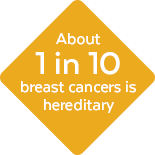About Breast Cancer
Breast cancer is a type of cancer that forms within the breast tissue. This can happen when healthy breast cells develop changes that cause them to rapidly grow and divide, forming a tumor. Breast cancer may spread beyond the breast to other parts of the body.
When breast cancer spreads to nearby tissue or lymph nodes, this is called locally advanced (LA) breast cancer.
If breast cancer spreads further to other organs, like the lungs, bones, liver, or brain, this is known as metastatic breast cancer (MBC).
TYPES OF BREAST CANCER
Although people sometimes refer to "breast cancer" as a single disease, in reality, there are many types of breast cancer based on certain characteristics of the cancer cells.
After you are diagnosed, your doctor will determine which tests are needed to help guide your treatment plan.

WHAT IS HER2- LA/MBC?
One way that locally advanced or metastatic breast cancer (LA/MBC) can be classified is based on the amount of HER2 protein on the surface of breast cells. If the LA/MBC cells have only small amounts of HER2 protein, the cancer is considered HER2-negative (HER2-).
HER2- LA/MBC AND HORMONE RECEPTORS
HER2- LA/MBC can be classified based on whether the tumor cells contain proteins called hormone receptors.
- Hormone receptor-positive (HR+) is a breast cancer subtype in which the cancer cells contain either the estrogen and/or progesterone receptors. These cancer cells will grow in response to estrogen and/or progesterone hormones, respectively.
- Hormone receptor-negative (HR-) is a breast cancer subtype in which the cancer cells have little to no estrogen or progesterone receptors.
Based on whether or not your HER2- LA/MBC has hormone receptors, it can be classified as either:
HR+, HER2- Breast Cancer


Triple-negative Breast Cancer (TNBC)



INHERITED BRCA GENE MUTATIONS AND CANCER
After a patient is diagnosed with LA/MBC, a doctor may also order a blood test to determine whether the cancer is classified as “germline BRCA-mutated” (gBRCA-mutated).
BRCA1 and BRCA2 are genes that everyone has within their cells. Normally, BRCA proteins help repair damaged DNA inside the cell.
But if either the BRCA1 or BRCA2 gene has an inherited, or germline, mutation (sometimes abbreviated as a gBRCA mutation), the DNA repair processes within the cell can be defective and, in some cases, lead to the formation of tumors. Because these gBRCA-mutated cancer cells cannot use BRCA to repair their DNA, the cells rely on other DNA-repair proteins, like “poly (ADP-ribose) polymerase” (PARP), to keep the cancer alive.
If you have HER2- LA/MBC with a gBRCA mutation, there are different treatment options that may be right for you—like TALZENNA.
HEREDITARY BRCA MUTATIONS
Hereditary BRCA mutations can be passed on from one generation to the next.
Although hereditary breast cancer is more common in women, men with inherited gBRCA mutations also have an increased risk for developing breast cancer.
Patients with hereditary breast cancer may be referred to a genetic counselor. Genetic counselors can offer guidance and education to patients and their families on BRCA testing and treatment decision-making.
Regardless of whether patients have a family history of breast cancer, gBRCA mutation testing is an important step in understanding if TALZENNA is the right type of treatment for them.
LEARN ABOUT TALZENNA HER2-=human epidermal growth factor receptor 2 (HER2)-negative.

